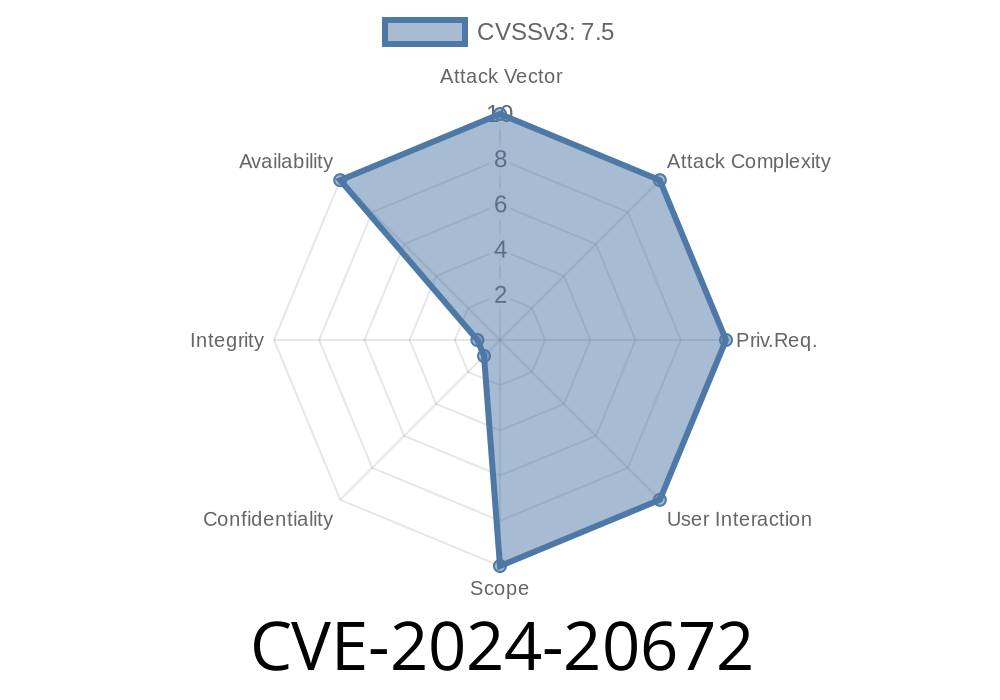CVE-2024-20672 is a crucial vulnerability discovered within the .NET framework, which could potentially lead to a Denial of Service (DoS) attack if exploited by malicious actors. As the security and reliability of the .NET framework are paramount for software applications, understanding and mitigating this vulnerability is critical for developers and system administrators alike.
In this in-depth analysis, we will explore the technical details of CVE-2024-20672 while also providing a code snippet to demonstrate the exploit and reviewing original references for further insights.
What is CVE-2024-20672?
CVE-2024-20672 is a security vulnerability discovered within the .NET framework, specifically identified as a Denial of Service (DoS) vulnerability. A successful exploit for this vulnerability allows attackers to cause a crash or slow down of the target application, disrupting the availability of services provided by the affected software running on the .NET framework.
Exploit Details
The vulnerability exists due to improper validation of user-supplied input data within the .NET framework. As a result, an attacker can send a crafted payload to a vulnerable application, causing an infinite loop or excessive resource consumption, leading to a Denial of Service attack.
The following code snippet demonstrates a simple proof-of-concept example for this vulnerability
using System;
namespace CVE_2024_20672_PoC
{
class Program
{
static void Main(string[] args)
{
// Crafted payload to trigger the vulnerability
string maliciousPayload = "a" + new string('x', 100000);
// Vulnerable function handling user-supplied input
VulnerableFunction(maliciousPayload);
}
static void VulnerableFunction(string input)
{
// Improper input data validation leading to the vulnerability
while (input.Contains("ax"))
{
input = input.Replace("ax", "a");
Console.WriteLine(input.Length);
}
}
}
}
This code snippet represents a simple implementation of the vulnerability, and in real-world applications, the impact may vary depending on numerous factors such as input parsing, application logic, and resource limitations of the target system.
Original References
For a comprehensive understanding and technical details of CVE-2024-20672, the following resources provide an in-depth analysis and reporting:
- Common Vulnerabilities and Exposures (CVE): CVE-2024-20672 official entry in the CVE database.
- Microsoft Security Advisory: The official Microsoft security advisory for CVE-2024-20672, including detailed explanations, affected product listings, and recommendations for mitigation.
Mitigation Steps
To address the CVE-2024-20672 vulnerability, developers and system administrators should implement the following recommendations:
1. Perform thorough input validation for all user-supplied data, ensuring that malicious payloads cannot trigger the vulnerability.
2. Update to the latest version of the .NET framework, which includes security patches addressing this vulnerability.
3. Regularly monitor security advisories and apply appropriate security updates and patches to mitigate the risk of known vulnerabilities.
Conclusion
CVE-2024-20672 is a concerning .NET Denial of Service vulnerability that has the potential to significantly impact software applications relying on the .NET framework. While this article has provided an overview of the vulnerability and demonstrated a proof-of-concept exploit, it is crucial for developers and system administrators to stay informed and act on the latest security updates and recommendations from trustworthy sources.
Timeline
Published on: 01/09/2024 18:15:50 UTC
Last modified on: 01/14/2024 22:48:45 UTC
